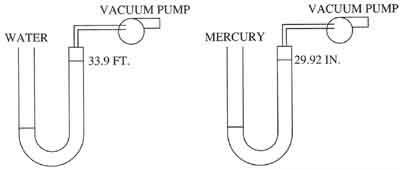 above: U-Shaped manometer |
Pressure below atmospheric pressure is called a vacuum. The pressure range of vacuum is from 14.7-0 psi on the absolute scale (psia) or 0 to -14.7 psi if you are using the gauge scale (psig). (Please realize that most pressure gauges read zero at atmospheric pressure so the common pressure gauge will need to read negative numbers to indicate pressures that are in the vacuum range.) This causes some problems when you are first introduced to pressure measurements since engineers and technicians will refer to the vacuum range as 14.7-0 psia, and you are trying to measure the vacuum with a gauge that reads the vacuum in values below 0. |
Another problem in reading vacuum with a gauge is that most gauges that are designed to read over 100 psi have difficulty when it comes to accurately reading small changes in pressures below atmospheric pressure. This problem is overcome by using a column of water or a column of mercury to measure values in the vacuum range. Scientists discovered that if they placed water in a U-shaped tube, allowed one end of the tube to be open to the atmosphere, and placed a pump on the other end to begin to remove all of the air from one side of the tube, the water in the tube would rise on the side where the air was pumped out. The U-shaped tube is called a manometer. The water was actually being pushed up the column by the atmospheric pressure (14.7 psi) pushing down on the open side of the manometer. Scientists found that 14.7 psi had the ability to raise the column to a height of 33.9 ft. This also means that a complete vacuum could lift a column of water 33.9 ft. When this experiment was duplicated and mercury was used in place of water, it was found that a complete vacuum was able to raise a column of mercury to a height of 29.92 in. This number may sound familiar because weather forecasters use a mercury manometer to determine if the atmospheric pressure is slightly higher or lower than 14.7 psi. The mercury manometer is called a barometer. If the atmospheric pressure is lower than 14.7 psi, it's said the barometer is falling, which usually means storms are approaching. Or if pressure is slightly above atmospheric pressure, it's said the barometer is rising and good weather is expected. The the diagram above shows one U-tube manometer with water in it and another with mercury. The diagram shows the amount of vacuum in reference to feet of water column and inches of mercury. As the vacuum gets stronger, it's called a deep vacuum or a complete vacuum. The mercury manometer is the preferred instrument when deep vacuum or complete vacuum readings are measured because it's smaller (approximately 30 in. tall) than a water manometer (approximately 33.9 ft tall). A water manometer can provide better accuracy because each inch of water column represents 0.036 psi, whereas each inch of mercury represents 0.49 psi.
Prev. Page: Pressure Paremeters | Next Page: Bourdon Tube Pressure Sensor
Related pages: Load Cells | Flow Meters